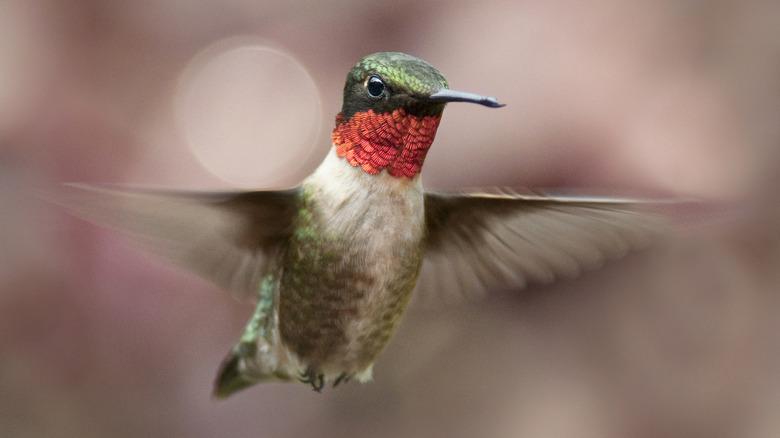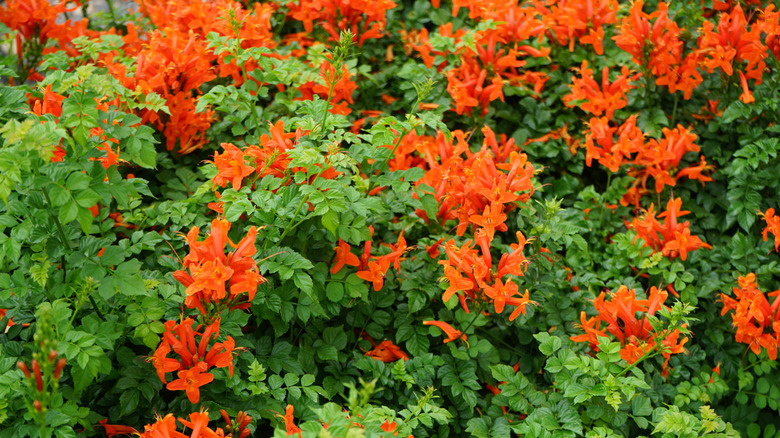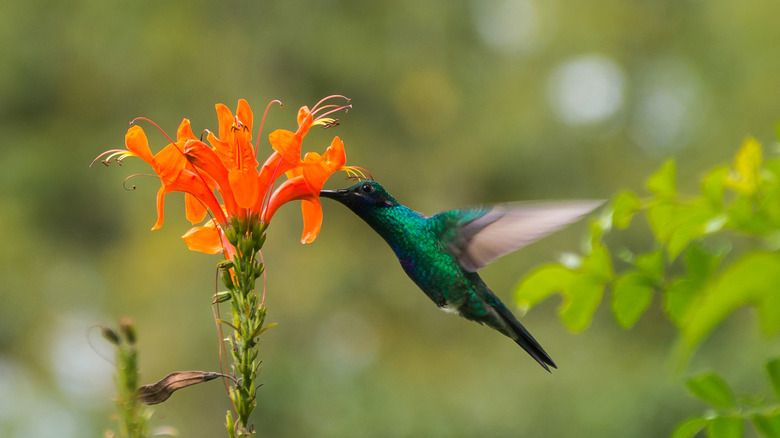The Vibrant Hummingbird-Attracting Shrub That Loves Damp Soil And Thrives In Heat
There are plenty of hedges and shrubs out there to choose for your yard. However, if you want a shrub that enjoys plenty of sunlight, heat, and moisture, and does a great job of bringing in pollinators like hummingbirds, there is one option that stands out as an obvious choice for most people in the southernmost part of the United States. This is the cape honeysuckle (Tecoma capensis). While cape honeysuckle isn't on the list of 25 flowers that hummingbirds absolutely love, it is still a major draw for these birds as well as several other pollinators.
Despite its name, this plant isn't actually a honeysuckle. It's not even in the same family. Instead, the name likely comes from the fact that it somewhat resembles a honeysuckle. It's part of the Bignoniaceae family, which is full of plants commonly called trumpet creepers, likely because of their flower shape and the fact that they're vining plants. While cape honeysuckle can vine, it also grows as a shrub, making it a great border plant around your garden, home, or yard.
Cape honeysuckle enjoys warmer temperatures, and thrives in USDA zones 9 to 11. It can be a pretty big plant, growing up to 20 feet tall and 15 feet wide. The flowers tend to bloom in the middle of winter, though in certain situations they can appear anytime between fall and spring. These flowers are the main draw of this plant, creating colorful blooms that are about 2 inches long and grow in clusters. They are also bright and come in a variety of colors including salmon, yellow, orange, and red.
Benefits of having cape honeysuckle growing in your garden
The flowers you'll find on cape honeysuckle shrubs are attractive to many pollinators. This is probably due to the color, as hummingbirds are huge fans of reds and similar shades, which is the color you should add to the garden to help attract them. They don't only bring in hummingbirds, but bees and butterflies as well. In addition to attracting amazing animals to watch, it has medicinal properties. It's said that you can harvest the bark and the leaves to reduce pain, fever, diarrhea, bronchitis, and insomnia.
Cape honeysuckle is a great choice for many gardeners because of its ability to turn into any kind of plant you need. While it is usually a shrub, it also acts somewhat as a ground cover. If you give it the chance to vine, you can set up a few trellis behind it and create a beautiful wall so you can see hummingbirds flying around multiple heights.
Another perk of cape honeysuckle is that it doesn't have any major problems. There are no insects or diseases that affect this plant, besides the possibility of whiteflies and spider mites if they are grown indoors. Altogether, this plant is easy to care for, which means you can focus on just letting cape honeysuckle do its own thing without the need for harmful pesticides and insecticides that could potentially also harm your lovely pollinators.
Cape honeysuckle care guide and warnings
With these flowers decorating your yard, you'll have plenty of time to sit outside and enjoy the birds. Perhaps you'll even start to learn and identify the types of beautiful hummingbirds you might find in your backyard. But first, you have to understand how to care for it.
Cape honeysuckle is adaptable and can tolerate some shade, but it prefers full sun and regular watering. However, they don't like sitting in water either. The best option is to plant them in soil that will stay moist and drain well. As long as they are in the right zones, cape honeysuckle is a perennial plant that will stay beautiful and green throughout the year. If the temperature gets too cold, though, the plant will lose its leaves and flowers.
It is worth noting that if you live in a state with lots of annual rain and a high average humidity, you may want to avoid using cape honeysuckle in your garden. In Australia, New Zealand, and Cuba, it is considered an invasive plant and while in the United States it doesn't have the same designation, there are a few states that do consider this plant to be a high invasion risk. All of Florida, a good part of California, and the lower parts of Southern states are all the perfect habitat for cape honeysuckle, and while they might not grow completely out of control, they do outcompete other plants in their vicinity thanks to their aggressive growth. In other zones, the plant grows well, but not at a rapid pace. Overall, cape honeysuckle is a great plant that with good care and management can be a wonderful part of your yard.


